A Closer Look at the Rat Park Experiment, Part 1
A Closer Look at the Rat Park Experiment, Part 1
By Kenneth Anderson, MA
Bruce K. Alexander’s rat park experiment series have become a very popular topic among people interested in addiction in recent years. The rat park experiments, published in 1978, 1979, and 1981, showed that albino Wistar rats living in a naturalistic environment with other rats consumed a lot less morphine than rats in solitary confinement in individual cages. In this article, I will give some of the historical background which led up to the rat park studies (Part 1), review the rat park studies themselves (Part 2), and take a look at where we have gone since (Part 3). A huge number of studies have been conducted on the effect of environment on addiction in animal models since the days of the rat park experiment, and we have found that in some cases the results are similar to rat park, but in other cases they are the exact opposite. The effects of genetics, environment, and substances combine in very complex ways indeed.
Rats hate the bitter taste of morphine and consume very little of a morphine solution under ordinary circumstances, hence, they do not develop morphine addiction in nature, although they are quite happy to consume a solution of cocaine. Prior to 1940, all experimenters had managed to do in animal experiments on addictive substances was to induce tolerance and withdrawal by injecting animals with morphine. In 1940, Sidney Durward Shirley Spragg was the first experimenter to teach animals to become addicted to drugs. Spragg injected chimpanzees with morphine until they developed physical dependence, then taught them to open a white box containing a syringe loaded with morphine when they started going into withdrawal and to open a black box containing bananas when they were hungry. Of course, Spragg had to inject the monkeys himself, but they often brought him the syringe from the box.
Psychologist Donald O. Hebb was the first to realize that rats living in solitary confinement in cages might behave differently than rats nurtured in a naturalistic environment. Although classical behaviorism treats the brain as a black box that can connect any stimulus with any response with equal ease, this proposition proved to be false quite early on. In his 1949 book The Organization of Behavior, Hebb describes how he took home two litters of rat pups from his lab and raised them as pets, then compared their performance on a rat intelligence test with rats raised in the lab. The rats raised as pets far outstripped the rats raised in a lab on these tests. Later experiments found that raising rats in an enriched environment affected the emotionality, conditionability, and body weight of adult rats.
Another milestone in the study of addiction in animals occurred in 1962, when James R. Weeks published an article describing a procedure which he had developed whereby rats could inject themselves with drugs by pressing a lever, much the way that rats learned to press a lever for food pellets in a Skinner box, aka operant conditioning chamber. This gave scientists an easy way to model addiction to any drug in any lab animal.
In 1969, Gerald Deneau et al. published a paper on rhesus monkey trials of morphine, codeine, cocaine, amphetamine, pentobarbital, ethanol, caffeine, nalorphine, Thorazine, and mescaline. Deneau was with the Department of Pharmacology at the University of Michigan, which did the animal trials on drugs before the drugs were sent to the Lexington Narcotic Farm for human trials. Trials of both limited and unlimited access were reported. The rhesus monkeys were in solitary confinement and fitted with a harness connected to a cage wall with a hinged arm; the harness housed a catheter to the jugular vein through which the monkeys could self-inject a drug by pressing a lever. The monkeys hated the harness and several managed to break the connecting arm; it took them two days to adapt to the harness and settle down. The harness and arm are illustrated below.
Still, the harness was an improvement on previous methodology, which had involved strapping the monkey into a restraint chair and just leaving one arm free to press the lever to deliver the drugs.
Deneau et al. found that the rhesus monkeys in these experiments would self-administer cocaine or codeine until they died. Deneau et al. reported that they had to limit access to drugs like cocaine to one dose per hour to prevent the monkeys from killing themselves with it. Interestingly, no deaths from self-administration of morphine were reported.
Two very important experiments were published in 1976. One was an experiment by Shirley Y. Hill and Barbara J. Powell on the effect of an enriched environment compared to an impoverished environment on drug self-administration in male Wistar rats. After weaning, when they were 20-days old, 15 rats were raised in an enriched environment much like rat park. They all lived together in a single chamber with a sand floor and had many toys and exercise wheels. Nine rats were raised in the standard solitary confinement of lab rats. When the rats were 100-days old, they were transferred into standard laboratory cages, given a seven hour per day drinking schedule, and given five days to acclimate to their new surroundings. After the five days were up, the rats were placed in a two-bottle choice situation for the next 16 days. Nine rats from the enriched environment group were given a choice between water and a morphine solution, six rats from the enriched environment group were given a choice between water and a cocaine solution, four rats from the solitary confinement group were given a choice between water and a morphine solution, and five rats from the solitary confinement group were given a choice between water and a cocaine solution.
The rats basically ignored the morphine solution because they couldn’t stand the bitter taste and there was no significant difference between the enriched environment rats and the solitary confinement rats when it came to consumption of the morphine solution. The cocaine solution was a whole different story. Rats from both groups drank a lot of the cocaine solution; however, the rats which had been raised in the enriched environment drank significantly more than those raised in solitary confinement.
The other 1976 experiment was conducted by Chris E. Johanson et al. This was the first study to focus exclusively on unlimited access to stimulants such as cocaine and amphetamine. The subjects were 15 rhesus monkeys, 12 male and three female. Monkeys were housed in solitary confinement in wooden boxes with plexiglass tops. Each monkey was fitted with a stainless-steel harness connected to the back of the box with a flexible spring arm, as illustrated below.
The experiment lasted 30 days. Two monkeys were given unlimited access to cocaine; both died after injecting themselves non-stop for five days. Two monkeys were given unlimited access to levo-amphetamine; one died after five days, the other lived through the experiment. Two monkeys were given unlimited access to methamphetamine; one died after three days, the other died after 15 days. Four monkeys were given unlimited access to dextro-amphetamine; one died on day two, one died on day four, one died on day 10, and one died on day 13. Five monkeys were given unlimited access to diethylpropion (a diet drug); one died on day 17, one became comatose on day 19 and never recovered, and three survived the experiment.
NEXT: Part 2, the rat park experiment and the studies themselves.



